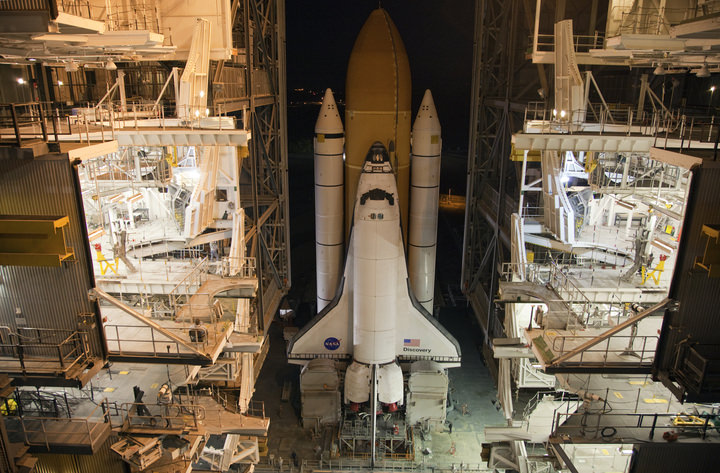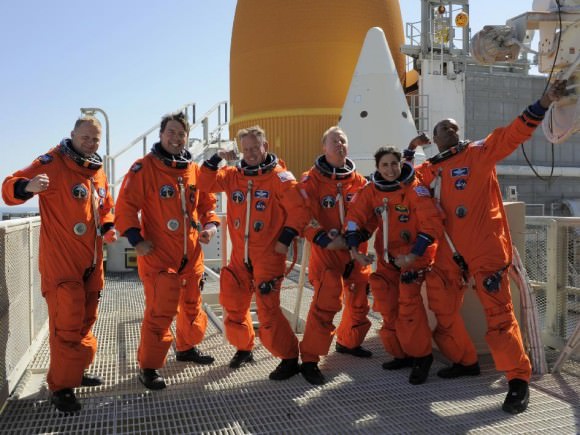NASA managers held a news conference at 2 p.m. EDT Tuesday, Jan. 11, at NASA’s Johnson Space Center (JSC) located in Houston, Texas. The conference was held to discuss Discovery’s STS-133 upcoming flight to the International Space Station (ISS). More importantly the conference went over how repairs to Discovery’s external tank (ET) are proceeding.
Shuttle program managers have already briefed officials with the space agency on Monday regarding the status of the repair work.
The 21-foot-long aluminum brackets, known as ‘stringers,’ are located along the intertank region of the ET. Engineers have been using ‘doublers’ to shore up and strengthen the areas that are damaged. Small pieces of metal called ‘radius blocks’ were used on the ET’s remaining stringers to provide extra-added strength.
Discovery was given an instrumented tanking test back on Dec. 17, where the ET was filled with super-cold liquid hydrogen and oxygen were loaded into the ET. Given that this can cause the tank to shrink by as much as half of an inch – NASA managers wanted to see what impact this had if any on the ET and Discovery’s full stack was rolled back to massive Vehicle Assembly Building (VAB) where this intertank section was scanned via X-Ray.
“There’s been lots of ups and downs to the process, said Bill Gerstenmaier, associate administrator for Space Operations. “It’s a combination of materials, deficiency in the tank… it’s not as fracture-tough as we would like. We’re essentially ready to roll forward.”
The first of these cracks was found on the orbiter’s ET during its Nov. 5 launch attempt. A leak at the Ground Umbilical Carrier Plate (GUCP) caused that attempt to be scrubbed. The GUCP has since been replaced and appears to no longer be an issue. During a review of the tank a cracked, popped up section of foam was discovered. Given the fact that it was a piece of foam that doomed the space shuttle Columbia back in 2003, this problem was taken very seriously. The foam was removed and it was found that the cracks extended to the tank itself. Further review found more and more cracks.
“We tested the removed stringers that we pulled off the tank,” said John Shannon, space shuttle program manager. “We ran fracture toughness tests on them and they had lower toughness that what we expected, but this wasn’t the complete answer to the problem that we had.”
Shannon went on to describe the complete process that was undertaken to determine what the root cause of these cracks was. He said that the cracks were caused at over three times the level of stress compared to what an orbiter’s ET normally sees during flight. Shannon along with other NASA officials said that the fix was easy to implement and that NASA was ready to go forward with launch.
“We were able to open a plan that allows us to launch a little earlier,” said Mike Suffredini, International Space Station Program manager. “We think we can support a launch date of the 24th of February.”
The status of Mark Kelly, the husband of Congresswoman Gabrielle Giffords who was shot over the weekend at an outdoor event, was briefly addressed. It was stated from the outset that this was not a topic for discussion with the family’s privacy being placed above other concerns.
“We’re going to let Mark decide what he wants to go ahead and do.” Gerstenmaier said.
Kelly is the commander of the STS-134 mission which is currently slated to launch from NASA’s Kennedy Space Center on Apr. 18. This will be the final flight of the space shuttle Endeavour.



Better late than never…
“it’s not as fracture-tough as we would like”
Again I’m left to wonder how many shuttles took off with undetected fractured stringers. I can’t believe that this is a isolated incident.
At last! The repairs are finished & Discovery has been rated as safe to fly. 🙂 Thank goodness the problem was detected in time to avoid a 3rd disaster & the loss of another 7 lives! 🙂 I’m looking forward to the last launch of Discovery, even though it makes one a little sad to think this is the end of the line for this space shuttle.
Thank You for taking the extra months to fix the external tank !!!
Now the 7 astronauts get to live !!!
It would have been more than tragic to have the last Shuttle flight end in a flaming disaster. Which it would have, had NASA ‘rushed’ the launch and not properly fixed the external tank.
STS-133 is not the last Shuttle flight – there are two others scheduled after this one.
“We always knew that an explosions was a possibility with the shuttle, we just always figured it would be on the way up as opposed to on the way down.” -on Columbia